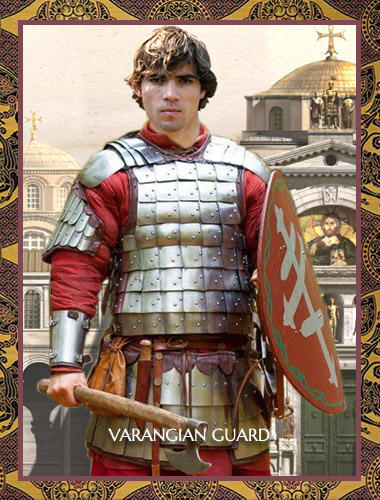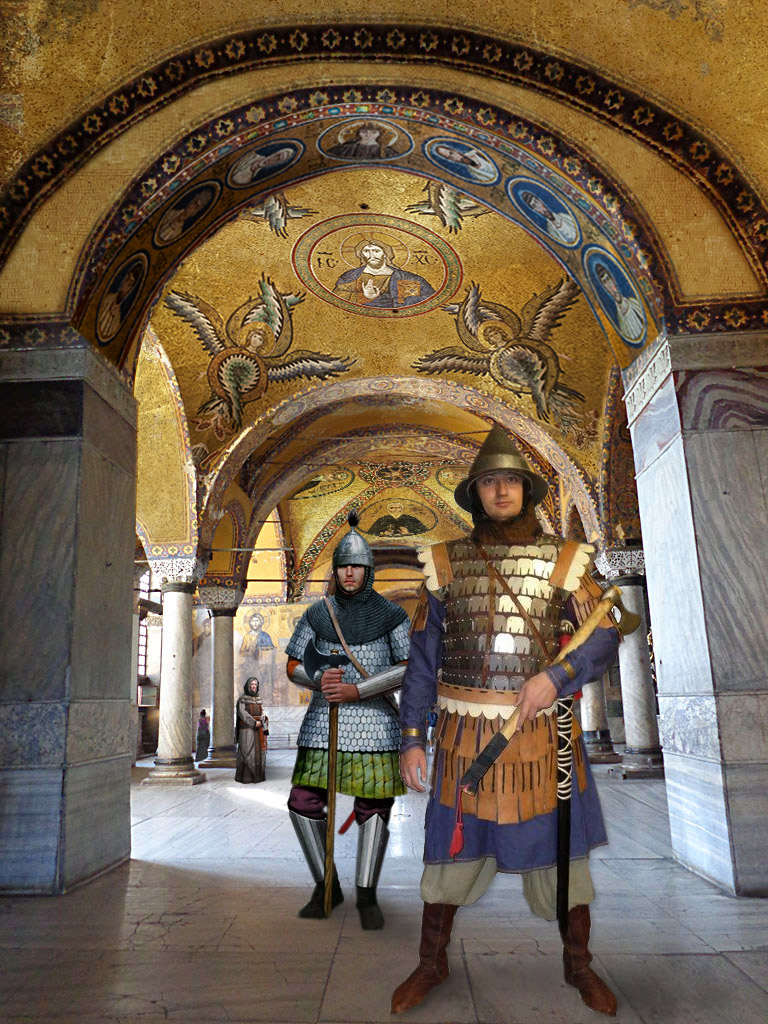 Viking Varangian Guard in the South Gallery of Hagia Sophia.
Viking Varangian Guard in the South Gallery of Hagia Sophia.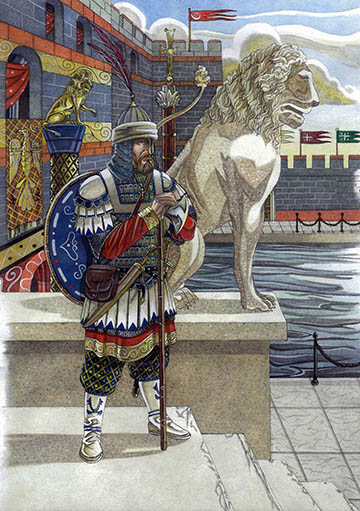 This Varangian Guard is standing outside the Boukoleon Palace, which was decorated with statues of lions and bulls. You can see banners on the right.
This Varangian Guard is standing outside the Boukoleon Palace, which was decorated with statues of lions and bulls. You can see banners on the right.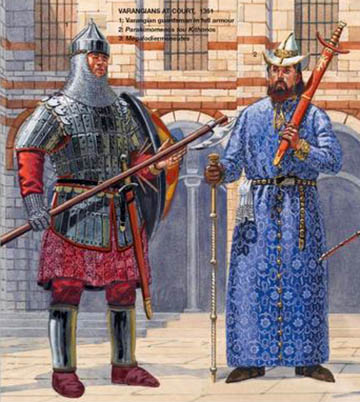 Here we see a guard and court official standing in the courtyard of the Blachernae Palace. He might not be a Varangian because he is not carrying an axe. That strange white hat was actually worn in late Byzantine times. Byzantine peaked hats were widely admired abroad.
Here we see a guard and court official standing in the courtyard of the Blachernae Palace. He might not be a Varangian because he is not carrying an axe. That strange white hat was actually worn in late Byzantine times. Byzantine peaked hats were widely admired abroad.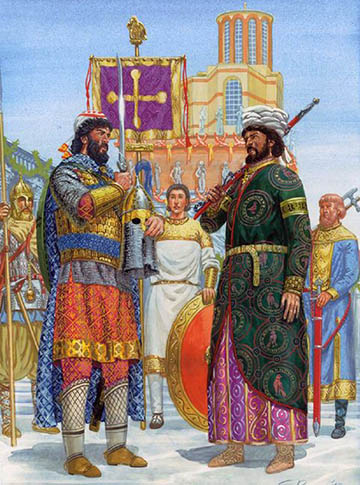 The Chalke Gate of the Great Palace had a high dome over it like this one.
The Chalke Gate of the Great Palace had a high dome over it like this one.

Four Scandinavian ship graffiti from Hagia Sophia
Thomas Thomov
New Bulgarian University, Sofia
This paper is the first presentation of four graffiti from the church of Hagia Sophia, Constantinople, and a contribution to the study of Viking graffiti of sailing vessels.
The term ‘graffiti’ signifies the act of writing or drawing on a hard surface. It also has a connotation of frivolity and destruction of the original. Graffiti are to be found incised on the walls and pillars of innumerable churches and often in places where they remain invisible for a long time. Most of them are valuable as examples of medieval art and some are important for their preservation of particular styles of epigraphy. In Constantinople in particular, they are to be found in the Great Church, the church of the Holy Wisdom Hagia Sophia, which was the greatest Christian cathedral for the Byzantine Christian world and the most important religious edifice in Constantinople. It is not surprising that all visitors to the imperial city, be they worshippers or ordinary tourists, first went to Hagia Sophia, a building of great fame; nor is it surprising that the individual worshippers have succumbed to the temptation of scratching graffiti on the marble revetments, balustrades, window-frames, doors and columns of the church. Some visitors inscribed their names, perhaps in the belief that they would receive salvation if their names were located inside the church of Hagia Sophia. Others may have written there because their freedom of expression was restricted elsewhere.
Curiously, the vast majority of graffiti are concentrated in almost all parts of the second-story aisles or galleries in Hagia Sophia. It is also appropriate to recall here that these places are called catechoumena or, very rarely, gynaikeion. Each is a corridor situated over the narthex and aisles of the church, usually open to the nave through arcades or colonnades. The public entrance to the galleries is at the northern end of the narthex, where a spiral ramp leads to the western and northern galleries. For the sake of brevity, I cannot embark into details here, but suffice it to say that, according to the traditional view, the upper galleries were considered to be a place for women or used as a means of segregation of genders and social classes.6 However, if we accept the view of scholars such as Thomas Mathews and Robert Taft, then it would be incorrect to state that ‘the galleries were the place of the women exclusively’ or that they ‘were reserved for the exclusive use of either catechumens or women’. In confirmation, it should be noted that certain sections of these galleries were exclusively reserved for the empress and her female attendants, or for the emperor and his male entourage, while other parts were used, on occasion, for synods of the Church. Although a significant number of imperial rituals took place in the galleries, liturgical activity was insubstantial there. Moreover, some galleries seem to have been used for a bewildering variety of activities, both legitimate and less so. Nevertheless, in the absence of any textual evidence, it is hard to conclude anything pro or contra regarding the presence (or not) of ordinary laity, male or female, in the other galleries.11 In my view, some support for ‘pro’ comes from the graffiti on the columns, walls and balustrades in the galleries. They seem to provide some evidence for the presence of ordinary people there. The question is whether the graffiti were scratched during a service or not. The answer to this question opens the door to various hypotheses. It is true that a significant proportion of the worshippers had plenty of time to scratch something into the marble due to the long services in the church. However, such an assumption would make us conclude that the galleries were open for everyone at any time. While this explanation is quite plausible, it is also possible that the visitor would walk through the empty galleries just to see how large the church was. In so doing, he might succumb to the temptation of scratching his name, following the example of many others before him. It should be said here that both explanations are plausible but we are not yet in a position to say precisely, in every individual case, whether the graffito was inscribed during the liturgy or not. In sup- porting one of the above possibilities we must turn our attention to the location, dimensions, depth and details of each graffito. All we can say with any assurance is that the upper galleries were a preferable place for graffiti because they were far from the direct view of any clergy officiating in the chancel.
Thematically, the graffiti may be divided into memoranda, inscribed mainly on the occasion of attendance at the church, various inscriptions of an invocative nature, human and animal figures, magical figures, ships, coats-of-arms, weapons, monograms and mason’s marks. The autographic, supplicatory inscriptions containing the formula ‘Lord, help Your servant X’ and those with the formula ‘X wrote’ occur frequently. The graffiti are written in Greek, Cyrillic, Armenian and Latin script letters. The forms of the letters in the graffiti of the eleventh to fifteenth centuries mainly agree with the paleography of written documents, the differences being accounted for by the specific technique of scratching out the inscriptions. The dating of the graffiti (except for dated inscriptions) was ascertained by paleographical comparison with dated written records. We must also bear in mind that only a small number have been published because much interest has been focused on the structure, interior decoration and arrangement of Hagia Sophia. On the other hand, each graffito-inscription is a piece in the gigantic puzzle of the church’s medieval history. If the graffiti were studied together, they would reveal an uncommon perspective on its history because the graffiti have not undergone any alteration. Furthermore, they reflect the thoughts of the authors who were often uneducated. The role of the historian is to piece the puzzle together and interpret its meaning.
The ship graffiti incised into the walls and columns of the upper gallery of Hagia Sophia was the subject of my fieldwork in 2010 and 2011. My research revealed drawings of sea vessels, nearly 35 in all, some crude and schematic, others remarkably detailed. Since these graffiti are drawings by crew members, we might expect an emphasis on those parts of the ships with which the sailors were most directly involved, namely the sails, the oars and the rudder. In fact, an analytical study of these graffiti confirms this observation. The great diversity of the types of vessels represented in these drawings is clearly noticeable. Some of the ships’ graffiti represent galleys, Viking ships, cogs, carracks, caravels and galleons. However, other graffiti are somewhat ambiguous, primarily due to poor carving. For this reason, it is not easy to determine the particular classification of a vessel based on a single graffito. Moreover, correlating the ships with the exact types mentioned in the historical texts and with shipwrecks is not always possible. Another difficulty with the pictorial studies of ships is to ascertain the ‘nationality’ to which the ships belonged. The types of ships and details of their rigging may give a hint of a ship’s origins, but this is not always reliable because of common ship-building traditions around the Mediterranean. On the other hand, several graffiti can be identified as Genoese ships by the banner on the stern with St. George’s cross.
In general, it may be said that ship graffiti provide an important source of information about the sailing vessels and their equipment in the Byzantine seas. They are physical evidence of people with anxieties and beliefs, passions and fears. They serve as a visual link between the present and the past; between the modern visitor and the man who wrote on the walls so many years ago. Only four of the maritime graffiti are connected to Viking sailing vessels and, in the present paper, I concentrate my attention on these. The first, located in the south gallery, shows a ship with a dragonhead on the prow. In the same place as the first graffito, we can see the second, which portrays the stems of three ships in a line. Another graffito, also in the same gallery, depicts two vessels in profile with high bows. Situated at the western end of the north gallery, the fourth graffito depicts a warship.
As I shall explain more fully, the graffiti indicate that various sea peoples, who probably originated from Scandinavia, visited Hagia Sophia. The information gathered from the analysis of the graffiti will also provide a primary research source for naval archaeologists and historians, helping them to understand the evolution of shipping types through the ages.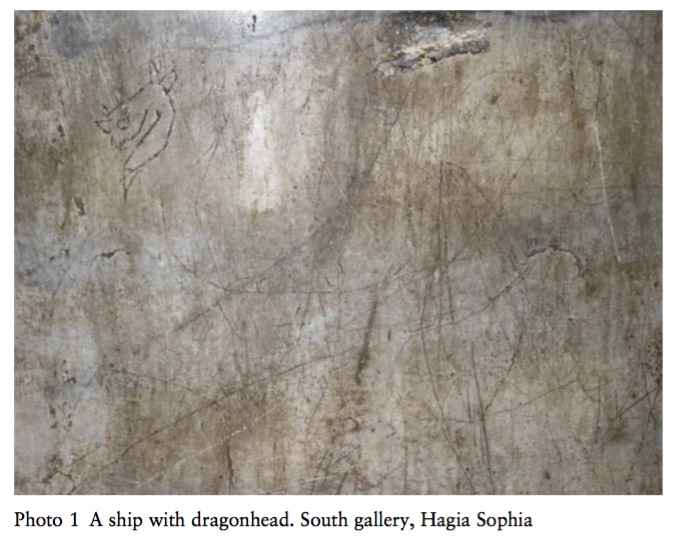
Focusing on the first graffito, we see that it is of particular interest because it is in the form of a complete ship. It is to be found in the western bay of the south gallery of the church. It was scratched into the northwest column (that is to say, immediately after entering the gallery) at approximately 1.39 cm from the floor by someone who was apparently standing up. The hull is long and narrow with a length of 14 cm and a height of 1.5 cm. Unfortunately, the technical details specific to the ship that can be extrapolated from the picture are few because only the stem, the most conspicuous part of the ship, (but not the whole vessel), is incised deeply into the marble (Photo 1). The ship, depicted from the port side, has a dragon-head adorning the prow. The animal head has a length of approximately 2.5 centimetres and a height of 4.5 centimetres. It is also worth noting the decorated stempost. Some of the lines on the stem could be interpreted as lines of the planking. This might be a convincing sign that the graffito-vessel was almost certainly Scandinavian, resembling the Oseberg ship, for example. The motif on the aft-stem is more difficult to define nowadays. Two round shields of the warriors are hung over the vessel’s sheer strake (that is to say, the top strake of the hull). This may have been their position in harbour and perhaps when sailing, but obviously they would have to be moved for rowing, and they can hardly have been secure when the ship was under sail. One vertical line in the middle of the ship constitutes the mainmast. Typically, the Viking ships had a central mast which was mounted in a block of wood. The mast, which could be raised and lowered, supported a large square sail made of heavy woollen or linen cloth. In our graffito-vessel the mast is raised and without a sail. On the side of the vessel two lightly sloping lines towards the prow and two downwards signify her oars. The Viking ship had a single bank of oars which were either rowed from benches affixed to the frames of the hull, or the rowers sat on hide-covered chests which contained their personal possessions. However, in our graffito we are given a hint of moorings instead of oars. Collating this with the position of the shields and the lack of a sail on the mast, we suggest that the ship-graffito represented a vessel in harbour. Another detail is a side rudder at the aft. As one can easily verify, the rudder was essentially a huge oar attached to the starboard side of the ship. In our case, however, it is shown as being on the port side. The other structure in the aft (with two vertical lines meeting one line slanting downwards to the aft) could be a type of cabin. As is always the case with graffiti, the problem resides in how far one can trust them.
If we try to compare the graffito ship with our knowledge of Viking vessels and archaeological evidence, we can see clearly that the narrow design of the hull, the animal head and the row of overlapping shields, as well as the tall, slender character of the stem, indicate that it can be considered as a Viking-Age warship with a dragon-head.
Warships were built for speed and manoeuvrability, and for the transport of men and loot from raids. They were slender and had holes for the oars in a continuous line along the length of the ship, a mast that could be lowered, as well as a large, square sail. Their main source of propulsion was the oar, with the mast lowered to reduce wind resistance and to improve stability. They are also distinct from other types of ships through having a shield-batten on the outer side of the top strake, and some ships were furnished with figureheads (and sometimes tails).
Without going into unnecessary details it will be sufficient to recall that the interest in the appearance and functions of Viking ships dates back a considerable time. Most of our knowledge in this field has been gained both from the sagas and from the excavation of the burial-sites at Tune, Gokstad, and Oseberg in Norway. The ritual purpose of the burial ships was to transport the departed to another world. The ships excavated at these famous sites provided an insight into the shipbuilding of the early Viking Age and presumably represent a universal ship-type used for warfare, trade or voyages of colonization. The archaeological evidence, provided by the vessels excavated at Ladby (1934–36), Skuldelev, Hedeby and Roskilde fjord in Denmark, between 1962 and 1997, reveals ship-types for more specialized activities such as trading (cargo ships) or warfare (warships, used also for travel). In other words, by the year AD 1000, a clear difference in the details of hull design and rigging had been established between the ships of the late Viking Age and the earlier ship-type from Norway. However, all of them belong to the same tradition of shipbuilding, being ckinker-built (the hull is constructed of overlapping planks), with a double-ended hull.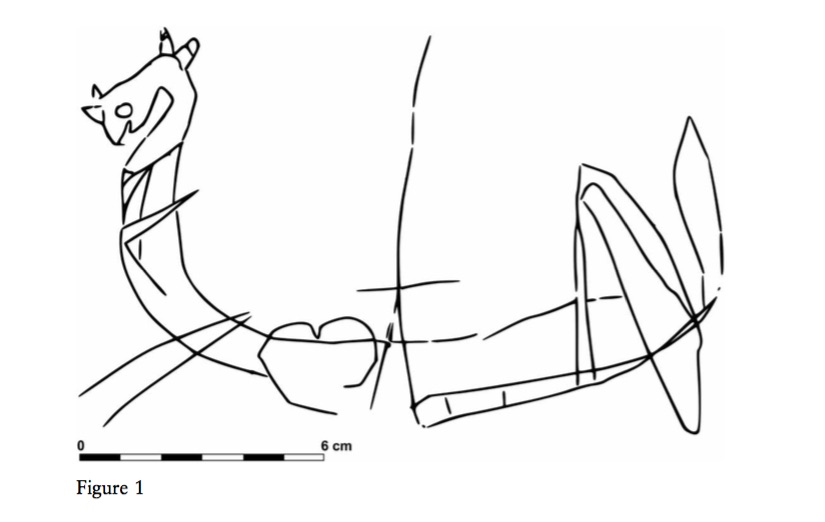
It is generally acknowledged that ‘long ships’ or langskips are ‘Viking’ ships. However, it is worth remembering that any kind of ship could be long and that ‘long ship’ is not a technical term. The most general term for a vessel which can denote both a warship and a cargo-ship is skip or knorr (in Sweden at least). It also occurs in compounds such as herskip (warship), langskip (long ship) or kaupskip (merchant ship). Skeið is a warship, but it is unclear whether or not it denotes a particular type of warship. Another name is snekkja which appears from the middle of the eleventh century and apparently it was smaller than a skeið. For this reason, I am inclined to use the term ‘warship’ for the graffito-vessel. In this scheme of things, behind the kenning dreki (drake), we can probably see a poetic conceit for a large warship and not a ship-term proper.
The problem now is to identify the ship-type represented by the graffito. It appears to depict relatively short vessels, rather than the extremely elongated form of some of the warships from the late Viking Age. It is also questionable whether true longships would have been particularly suitable for the lengthy voyage on the Russian rivers to Constantinople instead of relatively small and shallow vessels. It should also be noted that in many places, such as Russia, the journey involved carrying the ships themselves overland for short distances, and the smaller ships were apparently much more suitable for this. The obvious conclusion to be drawn from the above factors is that the graffiti represent a universal ship-type from the early Viking Age used for warfare or trade. Some support for this earlier date derives from the drawing style of the dragon-head. The ribbon-shaped body with protruding ears shows similarities with the Borre style (c. AD 840–970).
However, what is most important in the graffito-vessel is that the drawing is focused on the dragon-head, rather than on the whole ship. It is not difficult to provide a reason for this. The dragon-head was also intended to express the status of the ship’s owner. It served as a visual symbol of power, wealth, and prestige. Any ship could be called a dragon if equipped with an animal-shaped head on the stem.
Grotesque, carved animal heads (particularly of dragons - ’serpents’) were often used by the Vikings to adorn the prows of their warships and were one of the most prominent parts of the ship. It is a northern European custom dating back to at least the 1st– 2nd centuries AD, as is confirmed by Norwegian rock-carvings. Dragons were a favourite figure-head for Viking ships, but unfortunately no actual example has survived. Such vessels were the pride of their owners, displaying craftsmanship of superb quality.
There is also good reason to believe that in some cases, if not in all, the dragon-head was not permanently fixed to the prow, but could be attached and detached at will.36 Moreover, when not being used, the ships were kept in sheds and while they were there everything that was not secure was removed, even planks of the deck and the dragon-heads. This gives us the reason for the disappearance of the dragon-heads. They have not survived mainly because of their mobility. Icelandic law (‘Landnámabók’) stated that the stem dragons should be removed on approaching land lest the island’s guardian spirits took flight. This also indicates that the dragon-heads had an apotropaic effect. Ships without removable dragon-heads sometimes had spiralling snakes at the bow and stern. The toothy and bug-eyed figureheads on Viking ships would scare away enemies and evil spirits both on land and sea. They would provide protection for ships and their crews. The dragon-head made it easy to recognize a certain ship and clearly showed who the leader was and where he was in battle. As with the ornamentation of the stern, the purpose of the figure-head was often to indicate the name of the ship in a non-literate society (albeit in a sometimes convoluted manner) and possibly, in the case of naval ships, to demonstrate the owner’s status and prestige. This also means that common people would have owned or served on plainer vessels.
In Viking culture, the warship was the ultimate expression of their dynamism, its importance reflected in the proliferation of ship representations found on their memorial stones, coinage and in their graffiti. Love of their ships also continued into the afterlife, as indicated by the magnificent Gokstad and Oseberg ship burials and by the custom of using a man’s ship as his funeral pyre.
The obvious conclusion drawn from the findings above is that we are dealing with the ship graffito of a Scandinavian vessel from the early Viking Age, which represented the property of a wealthy man. Thus, the problem is to identify the ship’s owner. Given the meagre evidence at our disposal, it would be unwise to attempt such an identification. This individual must be sought from among those Nordic leaders (sometimes expelled or banished from their lands who acted as naval condotiers, undertaking service with whoever appeared to offer the best prospects of pay and loot. It is well- known that there was significant contact between Byzantium and the northerners from the ninth century onwards. The latter came to the Byzantine capital through the mediation of the Kievan Rus, who were partly of Nordic origin. Many such Vikings, referred to by the Rus, Arabs and Byzantines alike as ‘Varangians’, went on to Constan tinople and joined the Byzantine army, after a spell in Russia as happened in AD 911, 935, 941, 955 and 968. Twenty years later, in 988, prince Vladimir of Kiev sent as many as 6000 Vikings to assist the emperor Basil II, and it was from among these warriors that the renowned Varangian guard was subsequently established.
In seeking the evidence for our assumption, proposed above, we need to consult written sources such as the sagas. They narrate the journey of some northerners to Byzantium. However, the only certain visitor among the Nordic leaders to Constantinople was Harald Sigurdsson (or Harald Hardrada). There is reason to think that the journeys of all the others are historically somewhat dubious.
The second graffito (Fig. 2) is to be found at the western end of the north gallery. It has been incised into the marble column which is located near the public entrance, at approximately 1.70 cm from the floor (Photo 2). It is clearly a warship because of the shape of its hull. The sailing direction is towards the left and the vessel is 10 cm long. The forward slanting, straight stem is not present on Viking ships, but there are depictions with straight, vertical stems. Parallels for this graffito can be found among the ship graffiti from Himmelev Church. The vessel also has a single mast and a square sail. The slanting line behind the mast perhaps indicates a side rudder.
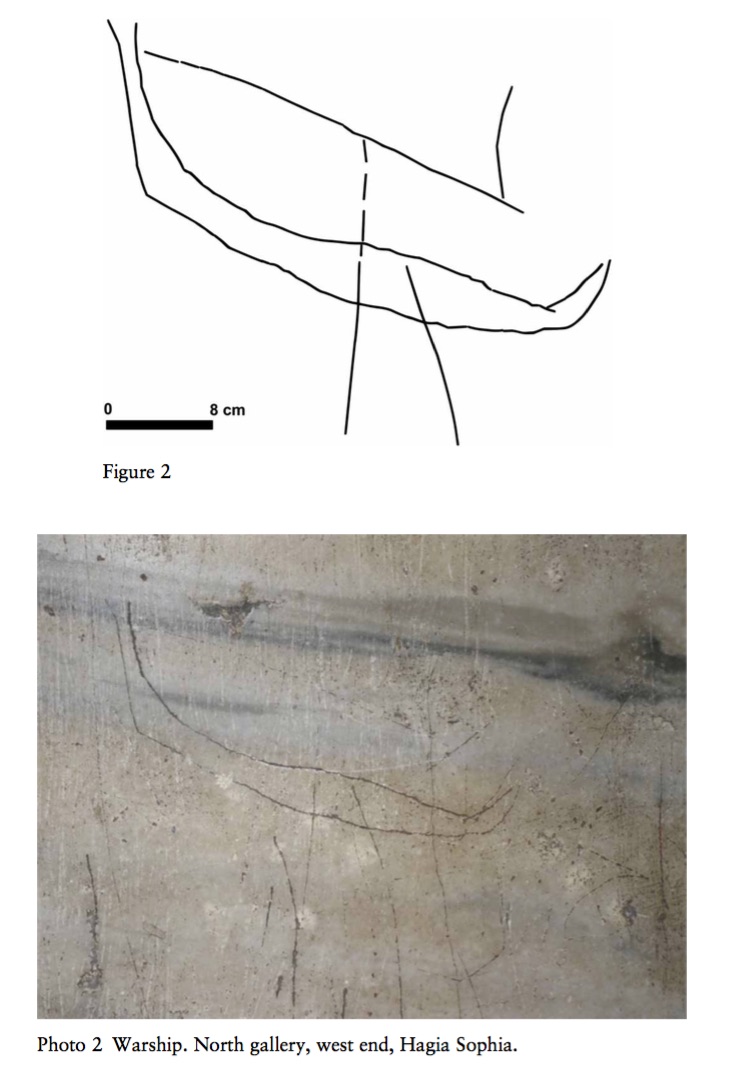
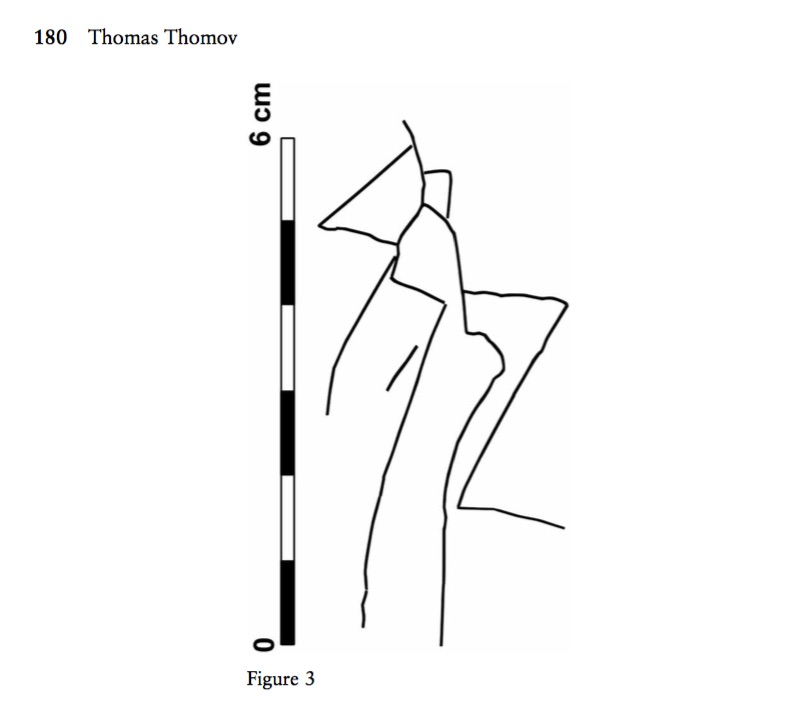 The third graffito (Fig. 3) is on the opposite side of the marble column from the first graffito. At approximately 1.52 cm from the floor the stems of three ships can be seen, in a line, overlapping each other so that one has the impression of looking at a fleet of ships (Photo 3). Most often only the stems and not whole ships are depicted. It is not difficult to provide reasons for this, bearing in mind that the stem was the most prominent feature of the ship. Support for such a view comes from the text in Snorri Sturluson’s Saga about Olav Tryggvason’s ship called ‘Long Serpent’. Unlike a literary text, our graffito does not tell us anything else about the ships. What then is the explanation? If we carefully examine the graffito, we shall find that the figure-heads, together with the tall, slender character of the stems, clearly show that the ships depicted in the fleet are indeed warships with dragon- heads arranged in battle order. As already stated, any Viking ship could be called a drakar if it was equipped with an animal-shaped head on the stem.
The third graffito (Fig. 3) is on the opposite side of the marble column from the first graffito. At approximately 1.52 cm from the floor the stems of three ships can be seen, in a line, overlapping each other so that one has the impression of looking at a fleet of ships (Photo 3). Most often only the stems and not whole ships are depicted. It is not difficult to provide reasons for this, bearing in mind that the stem was the most prominent feature of the ship. Support for such a view comes from the text in Snorri Sturluson’s Saga about Olav Tryggvason’s ship called ‘Long Serpent’. Unlike a literary text, our graffito does not tell us anything else about the ships. What then is the explanation? If we carefully examine the graffito, we shall find that the figure-heads, together with the tall, slender character of the stems, clearly show that the ships depicted in the fleet are indeed warships with dragon- heads arranged in battle order. As already stated, any Viking ship could be called a drakar if it was equipped with an animal-shaped head on the stem.
We can discern the same motif of ships in a line and some continuity of ship design on a piece of wood known as the ‘Bryggen stick’ found in Bergen, Norway. The stick was discovered in a stratum dating from between 1248 and 1332.50 It shows a row of vessels lying abreast of one another. Some of these ships have animal heads on their prows, others show vessels with wind vanes.
The fourth graffito is to be found on the east wall of the south gallery (Photo 4, Fig. 4). It has been incised into the right-hand side of the first marble window-frame, at approximately 1.30 cm from the floor. The two vessels depicted in profile are relatively small (7 x 4.5 cm), with high bows, and the sailing direction is to the left. The first ship shows the stem decorated with zigzag bends and the stern in the form of a tail. It has one mast and possibly a sail. Again, we can see that the drawing clearly depicts only the stem of the ship. We can conclude that the ship depicted is indeed a Viking warship because of the tall, slender character of the decorated stem. The second ship seems somewhat harder to categorize, primarily because of its poor carving. Only the high prow, without any decoration, is clearly visible, and it differs from the first one. However, it is more likely that the ship belongs to the type of Viking long ship. More specifically, the prow can be considered to be a pointer in that direction.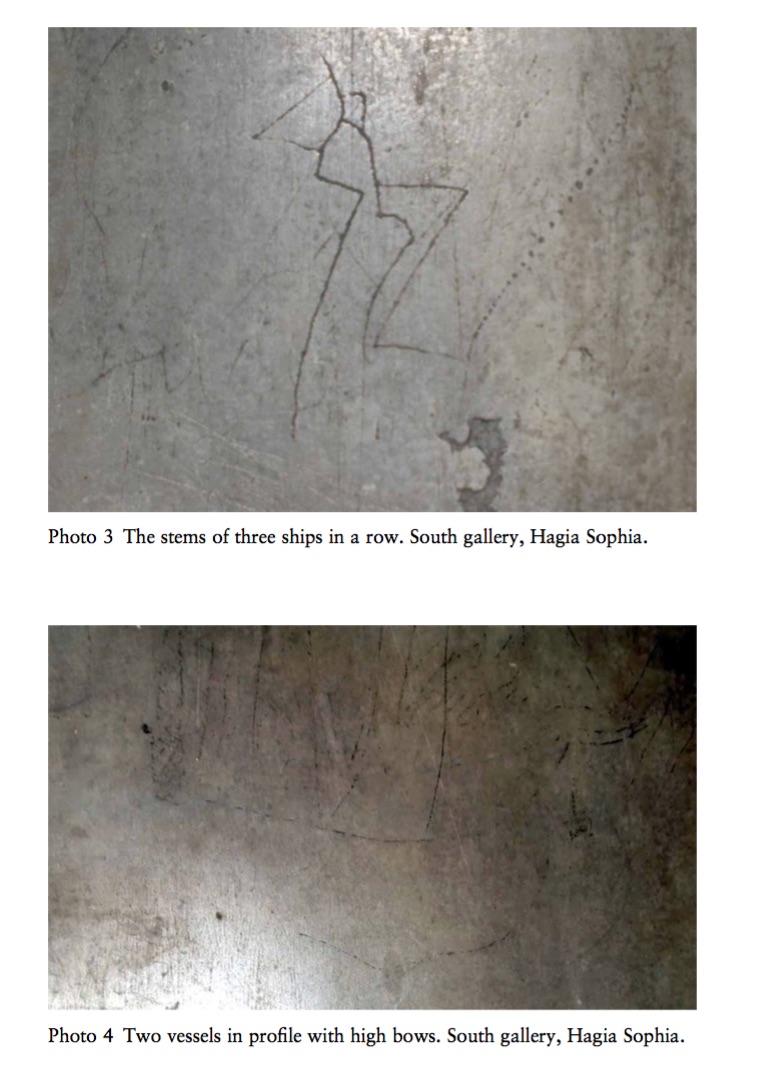
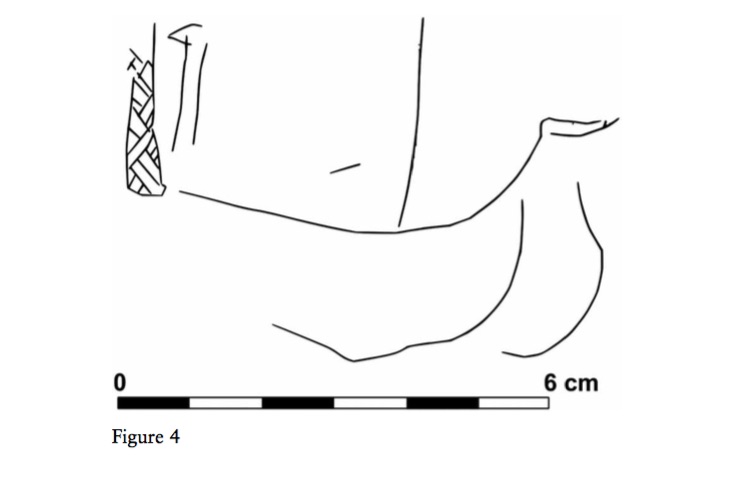 We can find parallels for this graffito in the Viking ships graffiti from the ‘Bryggen stick’ and from the north wall of the nave in the stave church at Fortun in Norway. It is appropriate to recall that in common with other Viking objects, wooden ships were sometimes decorated. Striking examples of Viking wood carving, on both stems, were found in the early ninth-century ship burial site near Oseberg, Norway. The latter ninth-century Norwegian Gokstad ship burial site also contained evidence of the carved zigzag lines that follow the upper strakes of the vessel. The case of the Ladby vessel from Denmark is very similar; it also appears to have had mouldings incised along the edges of some of the planking. During the thirteenth century, the decorations, which proliferated in the Viking Age ships, gradually disappeared.
We can find parallels for this graffito in the Viking ships graffiti from the ‘Bryggen stick’ and from the north wall of the nave in the stave church at Fortun in Norway. It is appropriate to recall that in common with other Viking objects, wooden ships were sometimes decorated. Striking examples of Viking wood carving, on both stems, were found in the early ninth-century ship burial site near Oseberg, Norway. The latter ninth-century Norwegian Gokstad ship burial site also contained evidence of the carved zigzag lines that follow the upper strakes of the vessel. The case of the Ladby vessel from Denmark is very similar; it also appears to have had mouldings incised along the edges of some of the planking. During the thirteenth century, the decorations, which proliferated in the Viking Age ships, gradually disappeared.
The scratchings or carvings of ships are difficult to date but as a rule it is possible to give a terminus ante quem or a terminus post quem – a time before which or a time after which the graffito was made. The established contact between Byzantium and the northerners from the ninth century onwards and the similarities between the graffiti and the universal ship-type used for warfare or trade from the early Viking Age provide a terminus post quem of the second part of the ninth- beginning of the tenth century. The terminus ante quem is the year AD 1000, when a clear difference in the details of hull design and rigging had been established between the ships of the early and late Viking Age. In this scheme of things, we are dealing with a period not earlier than the middle of the ninth century, nor later than the end of the tenth century.
The place where these ship graffiti were incised should be mentioned. Their location in the most renowned Byzantine church which was also the biggest in the world at the time was not by chance. We might note that if a Scandinavian’s first view of Constantinople inspired wonder, the church of Hagia Sophia, called Egisif, was the only edifice that was impressed on the collective Scandinavian memory. Consequently, there is nothing strange about the appearance of the graffiti in this location.
Unfortunately, we will perhaps never know who made these drawings. However, the fact that the graffiti demonstrate surprising workmanship details such as sails, rudder, oars, mast, board and even decorated and carved prows leaves no doubt that they were made by people who knew about the sea and the ships. It seems highly probable that the drawings were made on marble by a skilled hand using a stylos, an awl or a small chisel.
I want to discover the reason for the appearance of the graffiti in question. According to M. Goudas, ‘the reason for creating these representations ... cannot be other than simple amusement.’ Other scholars studying the graffiti have a different opinion. They characterize them as prayers of the seafarers who believed in the assistance they could receive from God or from gods. Another possible explanation is given by N. Ovcarov, who writes that sailors loved their vessels as creatures with a soul and believed that their voice was heard when they creaked in a storm. It is tempting, and not unreasonable, to choose one of the opinions cited above. However, if we consider their location, another possibility comes to mind. It clearly shows a complete lack of interest in Byzantine liturgy by the artist: he was hidden behind a column or was with his back to the central part of the church. This suggests that the graffiti were a way to pass the time. Anyone who has attended the whole of a long Orthodox service can appreciate that worshippers had plenty of time to scratch something into the marble.
In conclusion, I would like to add these four ship graffiti to the Scandinavian presence in Byzantium. They might be best taken as a sign of the Scandinavian activity in the Byzantine capital. Moreover, they are valuable sources in the efforts by scholars to reconstruct Viking vessels. In particular, this could be true for warships. Finally, it is important to note that many graffiti are in a bad state, mainly because of present day vandalism. In light of this, more attention should be paid to preserving these testimonies from the past as they are an important part of our maritime heritage.
DOWNLOAD THE PDF
Four Scandinavian Ship Graffiti from Hagia Sophia by Thomas Thomov with footnotes

